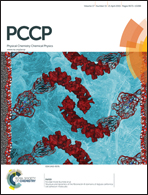Excited-state intramolecular proton transfer to carbon atoms: nonadiabatic surface-hopping dynamics simulations†
Abstract
Excited-state intramolecular proton transfer (ESIPT) between two highly electronegative atoms, for example, oxygen and nitrogen, has been intensely studied experimentally and computationally, whereas there has been much less theoretical work on ESIPT to other atoms such as carbon. We have employed CASSCF, MS-CASPT2, RI-ADC(2), OM2/MRCI, DFT, and TDDFT methods to study the mechanistic photochemistry of 2-phenylphenol, for which such an ESIPT has been observed experimentally. According to static electronic structure calculations, irradiation of 2-phenylphenol populates the bright S1 state, which has a rather flat potential in the Franck–Condon region (with a shallow enol minimum at the CASSCF level) and may undergo an essentially barrierless ESIPT to the more stable S1 keto species. There are two S1/S0 conical intersections that mediate relaxation to the ground state, one in the enol region and one in the keto region, with the latter one substantially lower in energy. After S1 → S0 internal conversion, the transient keto species can return back to the S0 enol structure via reverse ground-state hydrogen transfer in a facile tautomerization. This mechanistic scenario is verified by OM2/MRCI-based fewest-switches surface-hopping simulations that provide detailed dynamic information. In these trajectories, ESIPT is complete within 118 fs; the corresponding S1 excited-state lifetime is computed to be 373 fs in vacuum. Most of the trajectories decay to the ground state via the S1/S0 conical intersection in the keto region (67%), and the remaining ones via the enol region (33%). The combination of static electronic structure computations and nonadiabatic dynamics simulations is expected to be generally useful for understanding the mechanistic photophysics and photochemistry of molecules with intramolecular hydrogen bonds.


 Please wait while we load your content...
Please wait while we load your content...